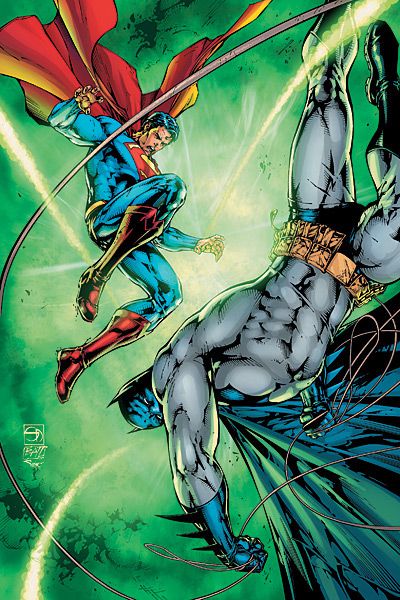Since this series began, it's been more of a Superman series than a Batman one. Both characters have received roughly equal page time, and they each get their narrative captions. (One of the nice features of this series since day one was Jeph Loebs's use of juxtaposed captions showing the contrasting worldviews of Superman and Batman, something Michael Green and Matt Johnson have used effectively in their issues, as well.) But the stories, largely involving transdimensional threats, alien invasions, and planet-wide shenanigans, have seemed to have more of a Superman scope. Part of the fun is seeing how Batman handles such situations -- things that are certainly not out of his league, but are beyond his normal day-to-day (or night-to-night) Gotham City obligations. Probably because of this larger, more epic context, the various writers of "Superman/Batman" have given us a confident, capable Batman -- one more in line with the classic Silver Age or early Bronze Age version of the character than the tormented grim avenger who has stalked the streets since the Frank Miller days. But, like most of the other story arcs before it, "K" is a Superman story, and Batman's just along as a potent sidekick.
The six-issue "K" storyline began with a simple premise: Superman wanted to rid the world of Kryptonite. Like an editorial decree of old, Superman decided that the DC Universe had too much of the green stuff floating around, and everyone and his brother had access to the only thing that could kill Superman. So, he and Batman began to round up all of the Kryptonite they could find, leading to some strange confrontations as Superman was forced to defend his hubris. Why should he be rendered completely invulnerable, thought others? Who is Superman to say that nobody should be able to stop him? "K" began with these kinds of questions but each issue has escalated into greater and greater conflicts, culminating last issue with a giant Doomsday clone made from Kryptonite. What could be worse than that? Finding out that Amanda Waller was behind the whole operation, building the Doomsday clone as a measure to protect America if Superman ever went rogue.
It was a series of absurd escalations to be sure, but Green and Johnson handled the character bits with flair, and the subtext of the Kryptonite-laden Doomsday was effective. Superman's worst nightmare came to life, created by the very nation he now called his home. Green and Johnson, with the more-than capable help of Shane Davis on pencils, were able to maintain the plot-heavy emphasis that's been a hallmark of this series, while still showing the complexities of the situation for the characters. In this final issue of the arc, the complexities increase, as Superman learns that LexCorp had designed the Kryptonite-laden weapons for the government. The complications arise not because Luthor is involved, but because he's not involved. As we've seen in "Superman" comics over the past year, Lana Lang is now in charge of LexCorp, and it's Clark Kent's old girlfriend who has helped build these weapons that can destroy him. It's Clark Kent's old girlfriend who, in "Superman/Batman" #49 presses the button and unleashes a Kryptonite dirty bomb, spreading a cloud of the deadly dust around the globe.
What's so interesting about Lana Lang's portrayal here is that she does it to protect the interests of her company. She does it, not out of spite or revenge or malice, but out of a sense of duty in her role as head of a corporation. There's also a hint, later in the issue, that Lana is not in control of her own actions, that there's a sinister force behind her deeds, but that's not the main thrust of the narrative here. It's betrayal, as Superman sees someone he trusts render his adopted home uninhabitable to Kryptonians.
Luckily, this is a comic book series, and a high-tech, deus ex machina solution quickly presents itself, and the Earth's Kryptonite cloud is soon dispatched. And even though Batman's just along for the ride in this story, he does get the final scene all to himself, even if is a retread of something we've seen several times in the past. There's only one person who Superman trusts with the remaining shard of Kryptonite, no matter who's telling the story.
Readers looking for a classic superhero romp, with a bit of an emotional underpinning, could do a lot worse than this recent "Superman/Batman" arc. It's not outside of continuity, but it's also not caught up in the whims of the "Countdown/Final Crisis" mentality. It's plot-heavy, slickly drawn superheroics, and sometimes that's enough.

